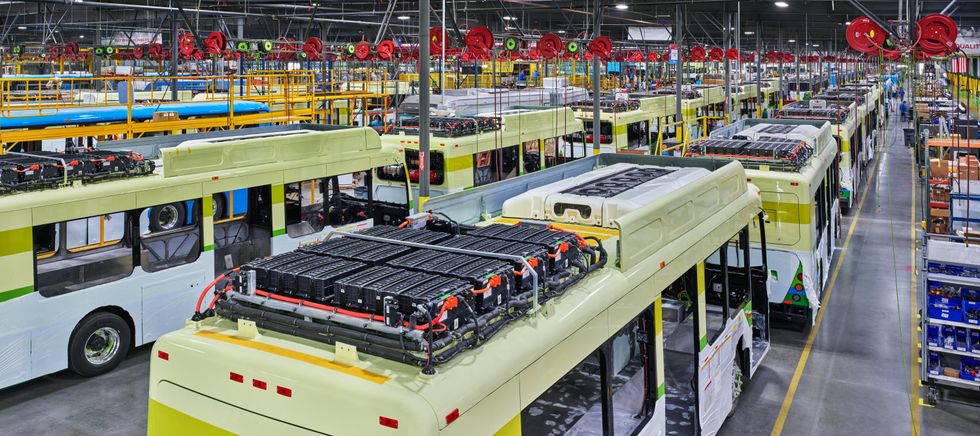Electric Buses Take Charge

The Big Picture features technology through the lens of photographers.
Every month, IEEE Spectrum selects the most stunning technology images recently captured by photographers around the world. We choose images that reflect an important advance, or a trend, or that are just mesmerizing to look at. We feature all images on our site, and one also appears on our monthly print edition.
Enjoy the latest images, and if you have suggestions, leave a comment below.
EV Bus Nursery
Pictured is the factory where electric-vehicle maker BYD, based in Santa Dominguez, Calif., builds its rechargeable transit and charter buses. BYD says it owes its preeminence in the electric-bus market to the fact that its buses' iron-phosphate batteries can be topped off through the AC or DC plugin ports, via overhead catenaries, and from inductive chargers embedded in road surfaces. Among the buses BYD is turning out is the Type J6, which can travel more than 140 kilometers on a single charge. Last year, four of them were put into service in Japan's first-ever all-electric public transit loop, in Kyoto. The 29-seater bus is also designed to serve as a mobile emergency power source that can plug into the grid during outages.
Christopher Payne/Esto
Whip It Out
Who would've thought that, after the century during which the Wright brothers first got us off the ground, aeronautics went from propellers to jets, and rockets took us to the moon, that the next big thing in getting objects off the ground would be a newfangled version of the catapult. But that's exactly the case being made by SpinLaunch, a startup based in Long Beach, Calif., that is developing giant centrifuges designed to fling payloads into the heavens at supersonic speeds. The launch setup pictured here features a 12-meter-diameter centrifuge the company says can spin a specially designed launch vehicle up to speeds of roughly 8,000 kilometers an hour before hurtling it through the opening in the tower. What makes a space catapult possible now? SpinLaunch explains that advances in the manufacturing of carbon fiber have yielded a tether strong enough to resist stretching or breaking in response to the g forces tugging on it as the launch vehicle comes up to speed.
SpinLaunch
Flight of the Bumblebee
We rightly marvel at the flight capabilities of hummingbirds and honeybees, whose mastery of pitch, roll, and yaw while flapping their wings makes such complicated maneuvers seem mundane. Harvard researchers have been trying to tease out how bees pull off their aerial acrobatics using a colony of robotic bees that they designed, and they're continuously equipping the bees with enhanced biomimetic features. The latest wrinkle in the RoboBees' development comes from an advance in their control system. The researchers have figured out how to more precisely manage the flapping of a robotic bees' wings so that control of a force called yaw torque can be incorporated into motion-planning scripts that govern their flight. The result: flapping-wing robots that can turn on a dime.
Wyss Institute/Harvard University
High Fidelity
One of quantum computing's main features-the built-in data security that comes from the inability to detect and document a qubit's quantum state-is also the source of one of researchers' greatest challenges. The tried and (mostly) true technique used for error correction in classical computers, which involves multiple reference copies of data that confirm the accuracy of the results of a machine's operations, is therefore unavailable for quantum error correction. With that in mind, researchers around the globe have been toiling away on quantum-computer setups that get their calculations right the first time. Shown here is a visualization of a two-qubit system based on the spins of a couple of entangled nuclei and one electron developed by a team at the University of New South Wales, in Australia. The researchers report that their nuclei-electron quantum devices have error rates as low as five-hundredths of 1 percent.
University of New South Wales